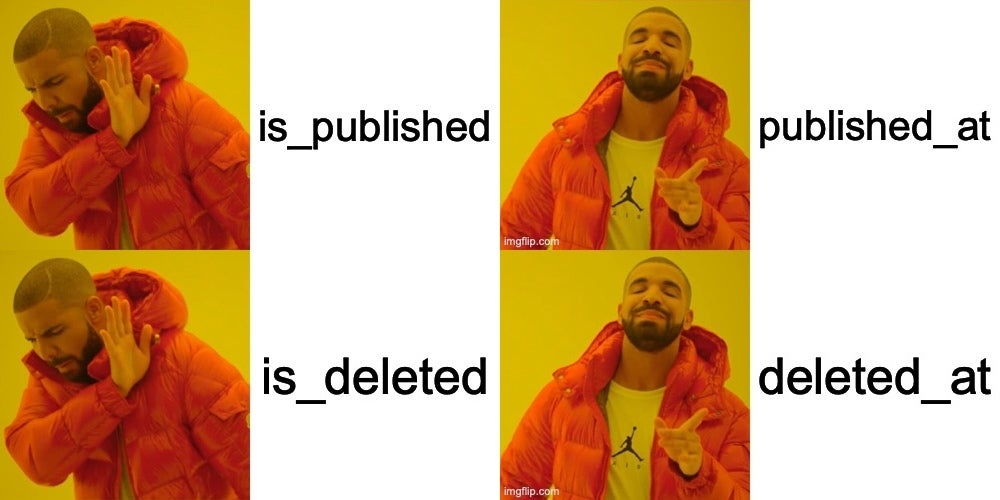Good point. However, approaching this problem from “YAGNI” point of view is a bit misleading, I think. If you are not going to need the timestamp, you shouldn’t add it to your code base.
In my opinion, hastiness is the culprit. When a property appears to be a binary one, we jump to the conclusion to use a boolean way too quickly. We should instead stop and ask ourselves if we are really dealing with a situation that can be reduced to a single bit. The point raised by the article is a good example: you may want to record the state change as timestamp. Moreover, in a lot of the cases, the answer is not even binary. The values for
is_publishedmay be, “Yes”, “No” or “I don’t know” (and then we will be too quick to assignnullto “I don’t know”). Underlying problem is that we don’t spend enough time when modeling our problems. And this is a sure way of accumulating technical debt.I think this timestamp-as-a-boolean is a good idea if the field is always going to be interpreted as either True or False and nothing more. If the field in question allows for a 3rd (uncertain) value, then using a timestamp would be extremely confusing.
And it all depends on the problem at hand. Any of those solutions can be acceptable as long as you have a well thought out model.
deleted by creator
Only really makes any sense for flags that go from false to true and don’t go back often. And even then it has huge semantic cost. How do you distinguish a “boolean timestamp” from an actual timestamp? Is “modified at” a flag indicating a pending modification or a timestamp when it was last modified?
Much better to just have two columns, so e.g. you can see “enabled” and an 'enabled_date" that indicates when you last enabled/disabled the entity.
Much better to just have two columns, so e.g. you can see “enabled” and an 'enabled_date" that indicates when you last enabled/disabled the entity.
That sounds good until you realize you now have two sources of truth, do you trust
enabledorenabled_date? If you really want to go this routeenabledshould be a virtual field that checksenabled_datein the background so you can have the boolean semantics but still keep a single field.I also used booleans a lot previously but since using Laravel I have come to enjoy the
updated_at,created_atanddeleted_atfields that it automatically creates and I follow this format as well now if I need more.But if it can be disabled we’d also need a disabled_date, however this implies that the state can switch from enabled to disabled and vice versa an infinite number of time, so we should create n*2 fields (enabled_date_1, disabled_date_1, …, enabled_date_n, disabled_date_n) where n is the maximum amount of state switches/2. Of course we’ll have to implement stream logging of events into a database, or at least some sort of counter, to determine the value of n, and then dynamically create new fields as needed.
Problem solved!
I think having an enabled_at field as nullable timestamp is enough.
If it’s present, it’s enabled. If it’s null, it’s disabled.
It’s a Boolean with context.If you really need to track the history of a record being enabled/disabled, I’d suggest this should be in another table. With postgres (not sure if it’s all DBs) you could create a trigger that when a record’s enabled_at field is updated, it creates a record in the log table with a from state, a to state, a timestamp, even a role/user.
That way, you could then extract the history of that record if required.
Tbh, if using postgres, you could just make a logging table that stores a JSON of the entire old record, and a JSON of the entire new record.
Would let you rewind the history of a record, see who did what, etc.Saves having an enabled and an enabled_at where there are potentially multiple sources of truth, or faffing around with arrays, multiple fields, over-pulling data
Yes my comment was definitely just a joke lol
Ehhh, I don’t quite agree with this. I’ve done the same thing where I used a timestamp field to replace a boolean. However, they are technically not the same thing. In databases, boolean fields can be nullable so you actually have 3-valued boolean logic:
true,false, andnull. You can technically only replace a non-nullable field to a timestamp column because you are treatingnullin timestamp asfalse.Two examples:
-
A table of generated documents for employees to sign. There’s a field where they need to agree to something, but it’s optional. You want to differentiate between employees who agreed, employees who disagreed, and employees who have yet to agree. You can’t change the column from
is_agreedtoagreed_at. -
Adding a boolean column to an existing table. These columns need to either default to an value (which is fair) or be nullable.
Using a nullable Boolean to represent 3 distinct states just adds confusion and complexity to your system. In most cases I would prefer to use an enum with 3 fields which is non nullable.
Yeah, this feels like “premature optimization”. When you design your applications and databases, it should reflect your understanding of the problem and how you solved it as best as possible. Using
DATETIMEOFFSET NULLwhen you actually meanBIT NOT NULLisn’t saying what you mean. If you already understand that you have a boolean option and you think you might need a timestamp to track it, use 2 columns. Or an audit table. So sayeth the holy SRP.Completely agree, I cram a timestamp column in every table, but booleans have their purpose too.
To add to this: the DBMS may treat null as unknown rather than not set. This may be not immediately obvious or noticeable, but it means a check requires different syntax and even double checks for set and value. Using null as ‘cleared’ goes against the DBMS definition of what null means.
As a side note: this difference in null behavior can become especially problematic when you use entity frame for to map tables and sql queries to C#. Because it’s not obvious and may not be known or seen.
-
How do you update it to unoublish? Add another timestamp column and who’s the latest win or just set published_at to null?
You wouldn’t store this information on the same table (unless you’re using a wide row db like dynamo/Cassandra). In a SQL world, you’d store version information in a separate table - one table for the HEAD state and another for history.
So, the history table have every column, but the user table has only user id and version, right?
user_history table user table
A CRDT Boolean is also pretty easy to write. Essentially it is just a last-write-wins element set with a single possible value and instead of representing if it is added or removed it represents true or false. To get the current state you take the latest timestamp. To merge two values you update the true and false timestamps to the latest of each.











